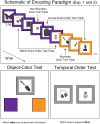Perceptual boundaries cause mnemonic trade-offs between local boundary processing and across-trial associative binding
- PMID: 29461067
- PMCID: PMC6013306
- DOI: 10.1037/xlm0000503
Perceptual boundaries cause mnemonic trade-offs between local boundary processing and across-trial associative binding
Abstract
Episodic memories are not veridical records of our lives, but rather are better described as organized summaries of experience. Theories and empirical research suggest that shifts in perceptual, temporal, and semantic information lead to a chunking of our continuous experiences into segments, or "events." However, the consequences of these contextual shifts on memory formation and organization remains unclear. In a series of 3 behavioral studies, we introduced context shifts (or "event boundaries") between trains of stimuli and then examined the influence of the boundaries on several measures of associative memory. In Experiment 1, we found that perceptual event boundaries strengthened associative binding of item-context pairings present at event boundaries. In Experiment 2, we observed reduced temporal order memory for items encoded in distinct events relative to items encoded within the same event, and a trade-off between the speed of processing at boundaries, and temporal order memory for items that flanked those boundaries. Finally, in Experiment 3 we found that event organization imprinted structure on the order in which items were freely recalled. These results provide insight into how boundary- and event-related organizational processes during encoding shape subsequent representations of events in episodic memory. (PsycINFO Database Record
(c) 2018 APA, all rights reserved).
Figures





References
-
- Atkinson RC, Shiffrin RM. Human memory: A proposed system and its control processes. Psychology of Learning and Motivation. 1968;2:89–195.
-
- Cimbalo R. Making something stand out: The isolation effect in memory performance. Practical aspects of memory. 1978;1(101)
MeSH terms
Grants and funding
LinkOut - more resources
Full Text Sources
Other Literature Sources
Medical

